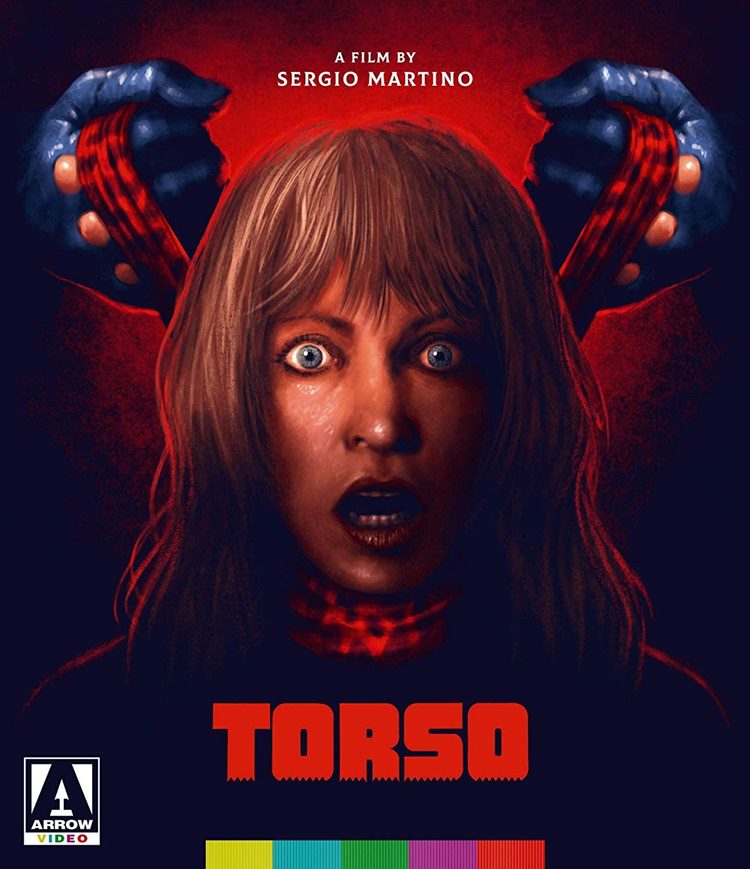
Torso (1973; dir. Sergio Martino) is pure, unfiltered giallo—a movie drenched in blood, nudity, and unapologetic sleaze. It’s rough around the edges, and the characters are paper thin. But the movie is a classic of its kind. It hints at the slasher films that would soon storm the world of horror.
Buy Torso 4K UHDThe premise? Simple: a masked psycho with sexual hang-ups (and a hacksaw) stalks and strangles college coeds with scarves before he dismembers them. When one girl recognizes his scarf, she (with friends) absconds to a secluded villa—because that always works out. What unfolds is Martino’s most brutal giallo.
Martino’s early ’70s work, like The Strange Vice of Mrs. Wardh and All the Colors of the Dark, was bangin’. Torso, the last in this streak, holds nothing back. With women ogled, stripped and butchered, it’s trashy and (arguably) problematic. But it does more than cater to base desires.
Torso is a wild ride through the male gaze. Here, Martino turns the objectification of women into an art form. Every dude in this flick, from the killer (who views women as “stupid dolls made out of flesh and blood”) to random street creeps, oozes toxic masculinity. Even the so-called hero, Doctor Roberto, is a suspect. Martino’s world is a hyperbolic reflection of male dominance. It forces us to confront the sleaze, and it makes us complicit in the voyeurism. Does Torso critique its own vulgarity or revel in it? That’s the $64,000 question.
But in the last 30 minutes, Torso reaches a new level. A near-silent showdown unfolds between Jane (Suzy Kendall) and the killer in the secluded villa. She’s injured, helpless, and desperate to stay alive. Martino cranks up the tension. His use of POV shots—both from the killer and the victim—puts you in the thick of it. This is where the movie slips from giallo to proto-slasher territory. The DNA of Halloween and Friday the 13th is all over it. But there’s an artistry here that the slasher rip-offs didn’t always reach. Martino layers in suspense, crafting a mood that sticks with you long after the credits roll.
Martino wasn’t a cut-rate Argento or Bava. He had a vision. In Torso, he plays with light, framing, and location in a way that lifts the material. The university streets of Perugia and the isolated cliff-side villa strike a contrast between urban paranoia and rural dread. An early lecture on Renaissance martyrdom becomes a twisted reflection of the carnage that follows. It’s a commentary on the collision of beauty and violence. It prompts us to question the artistic merit of the brutality Torso hurls at us.
For all its contradictions—sleazy yet stylish, exploitative but suspenseful—Torso deserves its place in the gialli pantheon. It’s sometimes hard to stomach, especially in its treatment of women; but if (like me) you love gialli, it’s essential viewing. Martino gives us a gauntlet. The movie is a slap in the face to moralists.
Torso isn’t perfect, but it’s not trying to be. Sleazy, stylish, and unapologetic—it knows what it’s doing. It doesn’t want to make you comfortable.
And if that doesn’t excite you, check your pulse.
While I received the 4K UHD disc and not Arrow Video’s full limited-edition package (with a reversible sleeve that features original and newly commissioned art by Adam Rabalais), Torso’s first 4K release shines. The 2K restoration and the DTS-HD Master Audio 2.0 mono sound impress. Fresh bonus material includes Troy Howarth’s audio commentary and a video essay by Michael Mackenzie. Exclusive to the limited edition is a booklet with essays. Other supplements—interviews with Martino and cast members; trailers; and a photo gallery—have appeared in earlier editions.